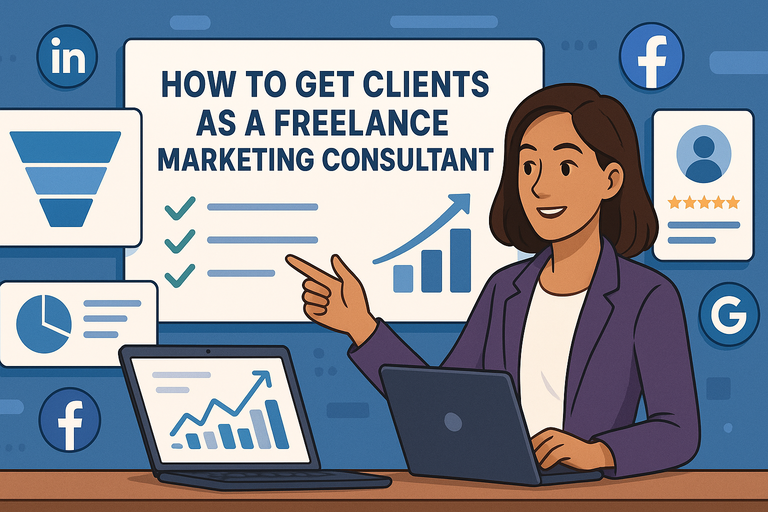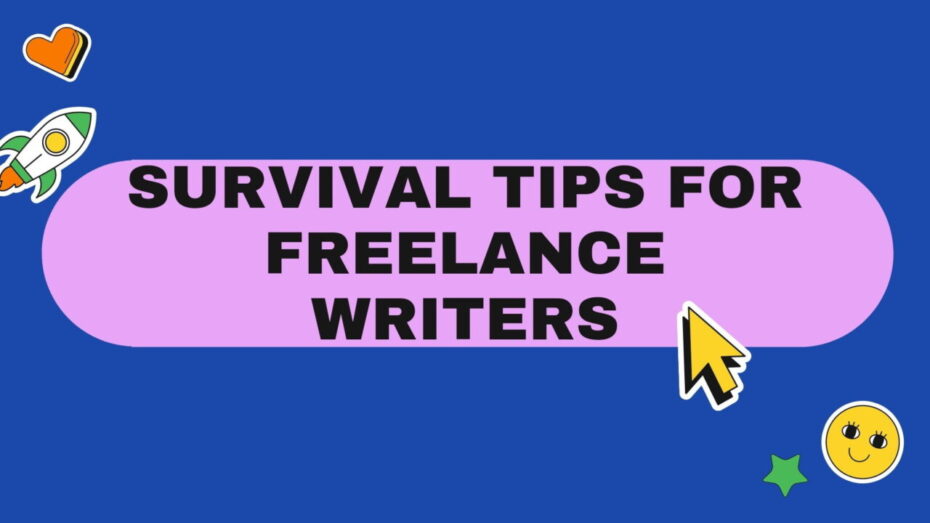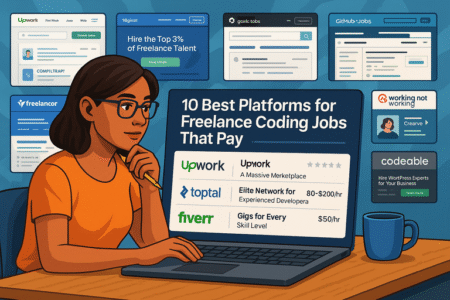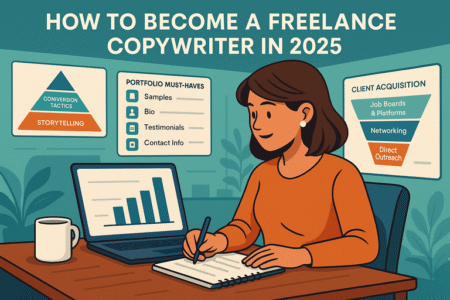Table of Contents
Being a freelance marketing consultant can feel exciting, but the biggest challenge is clear: how do you actually get clients fast enough to build momentum? If you’ve asked yourself how to find people who will trust and pay for your expertise, you’re not alone.
In this guide, I’ll walk you through practical, proven steps that will help you land your first clients quickly and create a steady pipeline of opportunities.
Define a Clear Value Proposition That Attracts Clients
Before you send a single cold email or post on LinkedIn, you need to know exactly what you’re offering and to whom.
A strong value proposition is the difference between “just another freelancer” and “the consultant I need right now.”
Identify Your Target Market and Niche
I recommend starting small instead of trying to serve everyone. Clients hire consultants who clearly understand their world.
For example, if you’ve helped e-commerce shops increase conversion rates, position yourself specifically as an “e-commerce marketing consultant” instead of a generalist.
A quick way to narrow your niche:
- Look at your past experience. Who have you helped before?
- Research where demand is growing (SaaS, DTC brands, coaches).
- Identify industries where you understand the language and pain points.
Here’s the key: Clients don’t care if you’re versatile; they care if you “get” their problems. A health tech startup will respond more to “I help health SaaS brands reduce churn with retention-focused marketing” than to “I do digital marketing.”
Create a Marketing Consultant Pitch That Stands Out
Once you’ve nailed your target audience, craft a short, clear pitch that says what you do, who you do it for, and the outcome you deliver.
A simple framework I use: “I help [specific type of client] achieve [specific result] through [specific service].”
For example: “I help Shopify store owners increase sales by optimizing email marketing and paid ad funnels.”
Keep it short enough to say in one breath. Then refine it so it sounds natural, not robotic. You’ll use this in your LinkedIn headline, your cold emails, and your intro when someone asks what you do.
Highlight Results Instead of Generic Services
Clients don’t want services; they want outcomes. Saying “I offer SEO, ads, and email” makes you a commodity. Instead, say “I help businesses get found on Google faster,” or “I increase revenue from email by 25% in 90 days.”
If you don’t have results yet, use small wins from your own projects.
For example:
- Grew your own LinkedIn following? That’s proof of audience-building.
- Optimized a friend’s website and improved traffic? That’s a measurable result.
Start tracking metrics early. Numbers like “increased CTR by 32%” or “cut CAC in half” instantly make you sound credible and client-ready.
Optimize Your Online Presence for Fast Client Wins
Once your value proposition is clear, the next step is to make it visible. Your digital footprint should act as your silent salesperson, convincing prospects that you’re worth their time.
Build a Simple Website That Converts Visitors to Leads
You don’t need a complex site with ten pages. A one-page site with a clear headline, proof of results, and a call to action can bring you clients faster than a bloated portfolio.
Here’s a layout I suggest:
- Headline – “I help [target clients] achieve [result].”
- Proof – Testimonials, logos, or case study highlights.
- Services – Three to four core offers (not ten).
- CTA – A calendar link (use Calendly or TidyCal) for discovery calls.
Example UI path: From your dashboard in Squarespace, click “Pages > Add Page > Blank Page.” Build out one scrolling page with clear sections instead of multiple tabs.
Keep it client-focused. Instead of “About Me,” use “How I Can Help You.”
Use LinkedIn Strategically to Position Yourself as an Expert
LinkedIn is a goldmine for consultants because decision-makers live there. But it’s not enough to just “be present.”
Steps to optimize:
- Headline: Use your pitch formula, not just “Freelance Marketing Consultant.” Example: “I help B2B SaaS startups generate consistent inbound leads.”
- Banner image: Use Canva to create one with a clear message, like “Email marketing that drives 30% more sales.”
- Content: Post short insights, quick wins, or lessons from projects 3x per week. Don’t overthink — even “3 mistakes I see e-commerce brands make with Facebook ads” can pull in prospects.
- DM strategy: Comment thoughtfully on posts from potential clients, then send a non-salesy DM like: “I noticed you’re scaling your SaaS product — are you currently running email campaigns to reduce churn?”
LinkedIn isn’t about spamming; it’s about showing up with consistent expertise.
Craft a Portfolio That Shows Proof of Results
Clients want to see your track record before they buy. A strong portfolio doesn’t need 20 projects — three solid examples with measurable outcomes are enough.
What to include in each case:
- The Problem: “This Shopify store had high traffic but low conversions.”
- The Approach: “I optimized their email flows and rebuilt their ad funnel.”
- The Result: “Revenue increased by 27% in 60 days.”
If you don’t have client work yet, showcase your own experiments. For instance, run a small Facebook ad campaign for your own website and show results. Or build a sample funnel in Mailchimp and explain how it would improve sales.
Pro tip: Design your portfolio in Notion for a modern, easy-to-share format. Create a page with sections for each project, then send prospects a live link. It feels more current than a static PDF.
Leverage Outreach Strategies That Work Quickly
When you’re just starting as a freelance marketing consultant, outreach is your fastest lever.
Clients won’t magically find you in the first month—you’ve got to put yourself in front of them with the right approach.
Write Personalized Cold Emails That Get Responses
Cold emailing isn’t about blasting 500 people with the same pitch. It’s about sending short, specific, human messages. A good cold email feels like it was written just for the reader.
Here’s a framework I use:
- Personalize the opening: Mention something specific you noticed about their business.
- Highlight a problem: Show you understand where they’re struggling.
- Offer a quick win: Suggest one actionable idea you could help with.
- Call to action: End with a soft, low-barrier ask like “Would you be open to a 10-minute call next week?”
Example:
“Hi Sarah, I noticed your Shopify store is running Facebook ads but you’re not retargeting site visitors. That’s often a missed opportunity for 20–30% more sales. I help e-commerce brands plug this gap. Would you be open to a short call to explore this?”
Pro tip: Use tools like Hunter.io to find decision-maker emails, then send through Gmail with GMass so you can personalize at scale without looking like spam.
Use LinkedIn DMs Without Sounding Spammy
LinkedIn is fantastic for outreach, but most people get it wrong by pitching too soon. Nobody likes opening a message that feels like a copy-paste ad.
Instead, follow a comment-first, connect-second approach:
- Comment genuinely on a prospect’s post for a week. Add insights, not “Great post!”
- Send a connection request that references your comment: “I liked your take on SaaS churn reduction—happy to connect.”
- After they accept, engage with their content before sending a DM.
When you do DM, lead with value:
“Hey John, I noticed you’re scaling your SaaS product. A lot of companies at this stage miss low-hanging email automation wins. If it’s useful, I can share a framework I use to increase trial-to-paid conversions by 20%.”
This positions you as a problem-solver, not a spammer.
Tap Into Existing Networks for Warm Introductions
Your fastest client might be one introduction away. Friends, ex-colleagues, and even family often know someone who needs marketing help.
Here’s how I suggest asking:
- Send a simple note like, “I’ve started freelancing as a marketing consultant helping [specific businesses]. If you know anyone struggling with [specific pain point], I’d love an intro.”
- Be clear and specific. Don’t just say, “I’m looking for work.” People help more when they know exactly what to look out for.
Bonus move: Offer to create a one-page explainer of your services that they can forward. Make it simple—headline, quick results, and your contact info.
Offer Quick-Win Services to Secure First Clients
Clients are hesitant to hand over big budgets right away. That’s why “quick-win” offers—small projects that show results fast—are your best foot in the door.
Package Small Projects as Entry Points for Clients
Instead of offering full-service marketing retainers, break your expertise into bite-sized packages. For example:
- A 2-week paid ad test campaign.
- A 3-email welcome sequence setup.
- A landing page optimization sprint.
These are easier for clients to say yes to because they’re lower risk. Once you deliver results, it’s much easier to upsell bigger engagements.
Pro tip: Present these as fixed-price packages on your website or proposals. Example: “Facebook Ad Funnel Starter Package – $750, includes setup, targeting, and first campaign.”
Use Audits or Consultations as Fast Trust-Builders
Audits are gold because they give value immediately and position you as an expert.
Here’s how I run one:
- Use Google Analytics or Hotjar for quick data insights.
- Record a 15-minute Loom video walking through 3 things they could fix right now.
- End with, “If you’d like me to implement this, I can handle it for you.”
Clients love audits because they see their problems clearly laid out. Even if they don’t hire you right away, you’ve built credibility.
Consultations work similarly. Offer a low-cost (or free for the first few) 30-minute strategy session. Frame it as “actionable takeaways, no fluff.” Then follow up with a paid service.
Price Smartly to Remove Barriers for First-Time Clients
Pricing is tricky when you’re new. Set it too high, and you scare people off; too low, and you undercut yourself. I suggest using tiered pricing:
- Quick-win package (low risk, $200–$500).
- Medium project (mid-level engagement, $1,000–$2,500).
- Ongoing retainer (long-term, $3,000+).
This lets clients choose their comfort level. Many will start small but eventually move up once they trust you.
Also, always frame pricing in terms of ROI. Instead of “This package costs $750,” say, “This package is $750 and is designed to add at least $3,000 in additional monthly sales.” That reframes cost as an investment.
| Service Type | Example Deliverable | Client Benefit | Price Range |
| Quick Audit | 15-min Loom video audit | Identifies easy wins | $200–$400 |
| Small Project | 3-email sequence setup | Immediate ROI boost | $500–$1,000 |
| Retainer | Ongoing campaign mgmt. | Long-term growth | $3,000+/month |
Tap Into Freelance Platforms for Immediate Opportunities
If you need clients quickly, freelance platforms can give you fast exposure. The key is not treating them as a race to the bottom but as places to strategically win your first projects and build credibility.
Use Upwork and Fiverr With a Strategic Approach
I know what you might be thinking—aren’t Upwork and Fiverr crowded? Yes, but they still work if you position yourself correctly.
Here’s how I approach Upwork:
- Profile headline: Be specific. Instead of “Freelance Marketing Consultant,” write “I help e-commerce brands grow with Facebook Ads and Email Funnels.”
- Portfolio samples: Upload 2–3 strong examples, even if they’re personal projects. Screenshots of dashboards (blur client data if needed) add credibility.
- Proposals: Keep them short, 150–200 words. Start by showing you read their job description, share a quick win idea, then invite them to chat.
For Fiverr, don’t sell generic “marketing services.” Create targeted gigs like “I’ll set up a high-converting email welcome flow in Klaviyo.” Use keywords your clients search for and add short demo videos showing your process.
Pro tip: On both platforms, respond to invites fast. Upwork’s algorithm rewards freelancers who reply quickly, pushing your profile higher in search results.
Pitch Effectively on Specialized Platforms Like MarketerHire
Platforms like MarketerHire, Toptal, or Growth Collective are different—they vet consultants before matching them with clients. The competition is higher, but the pay is also much better.
I suggest applying once you’ve got at least two strong case studies. The process often involves a skills test or mock project, so be ready with data-backed examples.
What I like about MarketerHire: Once you’re in, clients come to you. You don’t have to send endless proposals. It’s a great way to secure higher-ticket projects while you keep building your freelance pipeline.
Build Momentum With Testimonials From Short-Term Projects
Even small $300–$500 projects can turn into gold if you collect strong testimonials. Ask clients for specific feedback, not just “They were great.”
A powerful testimonial includes:
- The problem: “Our ad campaigns weren’t converting.”
- The solution: “She restructured our targeting and tested new creative.”
- The result: “Within 30 days, conversions increased by 42%.”
You can use these quotes on your website, in LinkedIn posts, or in proposals. The faster you build a wall of social proof, the faster you’ll attract bigger, long-term clients.
Create Partnerships That Lead to Client Referrals
Sometimes your best clients don’t come directly—they come through partnerships. Working with complementary professionals can unlock steady referral streams without cold outreach.
Collaborate With Web Designers, Copywriters, or Agencies
Think about it: Web designers build beautiful sites, but often the client then asks, “Can you help me market this?” That’s your entry point.
Here’s what I recommend:
- Reach out to 3–5 designers or copywriters on LinkedIn.
- Offer a trade: “If my client needs design work, I’ll send them to you. If yours needs marketing, send them my way.”
- Formalize it with a referral percentage if you want, e.g., 10% of the first month’s fee.
Agencies are also great partners. Many small agencies are strong in one area (like design) but lack marketing depth. Position yourself as their “on-call marketing consultant.”
Join Masterminds or Networking Groups for Warm Leads
Joining groups can fast-track introductions. Look for masterminds or Slack communities in your niche—like RevGenius for SaaS marketers or D2C groups for e-commerce consultants.
Instead of pitching right away, contribute value. Share a quick audit tip or answer questions. People will naturally reach out when they see you’re helpful and knowledgeable.
I’ve seen this firsthand—answering a simple question about email deliverability in a Slack group once landed me a $5,000 retainer client.
Offer Referral Incentives That Encourage Word-of-Mouth
Referrals are easier to generate if you sweeten the deal. For example:
- Offer $100 for every referral that turns into a paying client.
- Give a 10% discount on the next month’s invoice if a client brings in a referral.
You can even create a simple referral link using Bitly or ReferralCandy so partners track their rewards. The point is to make it easy and rewarding for others to spread the word about your services.
Build Authority With Content That Attracts Clients Fast
Authority doesn’t have to take years. If you share the right content consistently, clients will start reaching out to you instead of the other way around.
Share Quick Marketing Insights on LinkedIn or Twitter
Posting doesn’t need to be complicated. Think about the everyday insights you already use with clients. Turn them into bite-sized posts.
Examples:
- “3 subject lines that doubled email open rates for my client.”
- “One mistake I see e-commerce brands make with Facebook ads.”
- “Why most SaaS companies underuse their onboarding email flow.”
On LinkedIn, I suggest posting 3 times per week. On Twitter (X), shorter daily posts work better. Use Hootsuite or Hypefury to schedule posts so you stay consistent without being glued to your screen.
Write Mini Case Studies That Show Real Impact
Instead of just saying, “I helped a client grow,” show the numbers in a short case study.
A simple format:
- The challenge (e.g., “High CAC on Facebook Ads”).
- The approach (“We tested 3 new audiences and refreshed ad creatives weekly”).
- The result (“CAC dropped by 38% in 21 days”).
These mini case studies can be posted on LinkedIn, added to your portfolio, or even turned into a short PDF lead magnet. They show you’re not just talking theory—you’re delivering results.
Use Short-Form Video for Visibility and Fast Trust
Video is the fastest way to build trust because people see and hear you. And you don’t need fancy equipment—your phone works fine.
Ideas for quick videos:
- A 60-second tip on improving ad performance.
- A screen-record walkthrough of how you optimize email subject lines.
- A before-and-after of a campaign you improved.
Platforms like TikTok, Instagram Reels, and YouTube Shorts can work, but I’d focus first on LinkedIn, since that’s where most business decision-makers live.
Pro tip: Use Descript to auto-caption your videos—most people watch on mute.
Convert Conversations Into Paying Clients Quickly
Getting someone on a call or in your inbox is just step one. What matters is turning those conversations into signed clients—and doing it without pressure or gimmicks.
Ask the Right Questions in Discovery Calls
Discovery calls are not sales pitches. They’re about uncovering what the client really needs. I usually structure mine around three question buckets:
- Current state: “How are you currently handling your marketing?”
- Pain points: “What feels hardest or most frustrating right now?”
- Goals: “If we worked together, what outcome would make this a win for you?”
Listen more than you talk. Clients feel heard when you ask thoughtful follow-ups. I often repeat back their words—“So if I’m hearing you right, the main issue is high ad spend with low returns?”—which shows I understand and builds trust.
Pro tip: Use Calendly + Zoom for calls. From your Calendly dashboard, go to “Event Types > New Event,” then link it directly to Zoom so scheduling is seamless.
Create Simple Proposals That Don’t Overcomplicate Sales
One mistake I see consultants make is sending 10-page proposals. Clients don’t have time for that. I recommend a 1–2 page format:
- Summary of problem (in their words)
- Your approach (clear, step-by-step)
- Deliverables & timeline
- Price + ROI frame (“This $2,000 project is expected to save $5,000/month in wasted ad spend”)
- Next step (a button or link to accept)
Tools like Better Proposals make this super smooth. Clients can click “Accept & Sign” in seconds. The easier you make it, the faster they say yes.
Use Scarcity or Time-Bound Offers to Speed Up Decisions
Without pressure, conversations can drag on forever. A gentle push helps. I suggest two approaches:
- Limited spots: “I only take on 2 new clients per month, and I have one slot left for October.”
- Time-bound bonus: “If we start this week, I’ll include a free audit of your email flows.”
This isn’t about fake urgency—it’s about creating clarity. Clients want to know why they should decide now rather than later.
Maintain Momentum by Building a Client Pipeline
Landing your first few clients is great, but keeping a steady flow is what makes your freelance business sustainable.
Develop a Consistent Outreach Routine
I advise treating outreach like going to the gym—regular, consistent, and scheduled. For example:
- Daily: Comment on 5 LinkedIn posts.
- Weekly: Send 10 personalized cold emails.
- Monthly: Reconnect with 5 past clients or contacts.
Track this in a simple Notion CRM or even a Google Sheet. I personally use Notion with a board labeled “Leads > Conversations > Proposal Sent > Closed.” It keeps everything visible at a glance.
Set Up Automated Lead Nurturing With Email
Not everyone is ready to buy immediately. That’s where email nurturing helps.
A simple setup:
- Create a free lead magnet (like “5 Email Campaigns That Add Revenue Fast”).
- Use MailerLite to set up an automation: Dashboard > Automations > New Workflow.
- Send a welcome email + 3–4 follow-up tips over 2 weeks.
This keeps you top of mind. Later, when the lead is ready, you’re the consultant they remember.
Balance Fast Wins With Long-Term Retainers
Fast projects keep cash flowing, but retainers build stability. I usually think of it as a mix:
- Quick wins: Audits, small campaigns, one-off projects.
- Retainers: Ongoing email management, ad optimization, or monthly strategy sessions.
I suggest offering both. After you deliver a successful quick project, propose a retainer: “We could keep optimizing your campaigns monthly for $2,000. That way you keep scaling without starting from scratch each time.”
Expert Tip: Focus on Speed Without Sacrificing Quality
It’s tempting to chase speed so hard that you cut corners. But trust me, long-term success as a freelance marketing consultant comes from combining quick wins with quality delivery.
Avoid Burnout by Streamlining Your Offerings
Don’t try to be everything to everyone. I advise focusing on 1–2 core services. For example, “Facebook Ads + Email Marketing” is easier to manage (and sell) than trying to do SEO, content, design, and ads all at once.
This also keeps your workflow lighter. You’ll burn out fast if every client needs a completely new skill set.
Use Repeatable Systems to Deliver Consistent Results
The fastest way to scale yourself is with systems. I recommend:
- Templates: Proposal templates, onboarding forms, and reporting docs.
- Checklists: For campaign launches, audits, or email flows.
- Automation tools: Zapier to connect tools (e.g., new client in Stripe triggers a Slack notification).
A system might feel like extra work upfront, but it saves hours later—and makes you look professional.
Build Long-Term Trust While Landing Clients Quickly
Fast growth is exciting, but your reputation is the real asset. Overdeliver on your first few projects. Send an extra tip. Share a quick Loom walkthrough even if it wasn’t in scope. Clients remember that, and referrals follow.
Here’s my best piece of advice: every project is a portfolio piece and every client is a potential referrer. Treat them that way.
| Stage | Fast Win Strategy | Long-Term Play |
| Outreach | Cold emails, LinkedIn DMs | Partnerships, networking |
| First Projects | Quick audits, small packages | Retainers, full campaigns |
| Conversion | Simple proposals, scarcity offers | Strong authority & testimonials |
| Growth | Consistent outreach routine | Automated lead nurturing |






